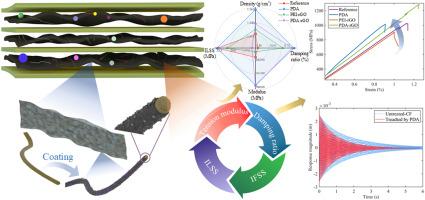Exceptional damping of CFRPs: Unveiling the impact of carbon fiber surface treatments
IF 12.7
1区 材料科学
Q1 ENGINEERING, MULTIDISCIPLINARY
引用次数: 0
Abstract
A significant body of research has concentrated on augmenting the interfacial slippage between carbon fiber (CF) fabrics and resin to improve the damping properties of CF reinforced plastics (CFRPs). However, a critical but commonly overlooked issue lies in the fact that a higher number of mutual slippage interfaces may lead to potential debonding at the interface. This, in turn, not only influences mechanical properties but also escalates the risk of structural damage. In this study, three distinct modification methods are proposed to alter the surface characteristics of CFs, achieving simultaneous enhancement of the damping and mechanical properties of CFRPs. Specifically, the polymerization of dopamine on the CF surface results in CFRPs with a loss factor of 0.227 at 1 Hz, which is 180 % higher than the 0.081 of referenced CFRP. Additionally, using this modification method, the tensile modulus and strength of the CFRP are increased by about 11.3 % and 6.7 %, respectively. More importantly, the subtle relationships within the CFRPs interface are explored through the different surface modification methods. The interactions between surface wettability, specific surface area, roughness, and interfacial chemical bonding on the mechanical and damping properties are redefined and elucidated. This study demonstrates that surface modification can simultaneously enhance both the damping and mechanical properties of CFRPs, and a satisfactory balance of multiple enhancement effects can be achieved by adjusting the surface modification factors.

CFRP 的超凡阻尼性能:揭示碳纤维表面处理的影响
大量研究都集中在增加碳纤维(CF)织物和树脂之间的界面滑移,以改善碳纤维增强塑料(CFRP)的阻尼特性。然而,一个关键但通常被忽视的问题在于,相互滑动界面的数量越多,可能会导致界面处的潜在脱粘。反过来,这不仅会影响机械性能,还会增加结构损坏的风险。本研究提出了三种不同的改性方法来改变 CF 的表面特性,从而同时提高 CFRP 的阻尼和机械性能。具体来说,在 CF 表面聚合多巴胺可使 CFRP 在 1 Hz 时的损耗因子达到 0.227,比参考 CFRP 的 0.081 高出 180%。此外,使用这种改性方法,CFRP 的拉伸模量和强度分别提高了约 11.3% 和 6.7%。更重要的是,通过不同的表面改性方法,探索了 CFRP 界面内部的微妙关系。重新定义并阐明了表面润湿性、比表面积、粗糙度和界面化学键对机械和阻尼特性的相互作用。这项研究表明,表面改性可以同时增强 CFRP 的阻尼和机械性能,而且通过调整表面改性因子,可以在多重增强效应之间取得令人满意的平衡。
本文章由计算机程序翻译,如有差异,请以英文原文为准。
求助全文
约1分钟内获得全文
求助全文
来源期刊

Composites Part B: Engineering
工程技术-材料科学:复合
CiteScore
24.40
自引率
11.50%
发文量
784
审稿时长
21 days
期刊介绍:
Composites Part B: Engineering is a journal that publishes impactful research of high quality on composite materials. This research is supported by fundamental mechanics and materials science and engineering approaches. The targeted research can cover a wide range of length scales, ranging from nano to micro and meso, and even to the full product and structure level. The journal specifically focuses on engineering applications that involve high performance composites. These applications can range from low volume and high cost to high volume and low cost composite development.
The main goal of the journal is to provide a platform for the prompt publication of original and high quality research. The emphasis is on design, development, modeling, validation, and manufacturing of engineering details and concepts. The journal welcomes both basic research papers and proposals for review articles. Authors are encouraged to address challenges across various application areas. These areas include, but are not limited to, aerospace, automotive, and other surface transportation. The journal also covers energy-related applications, with a focus on renewable energy. Other application areas include infrastructure, off-shore and maritime projects, health care technology, and recreational products.
 求助内容:
求助内容: 应助结果提醒方式:
应助结果提醒方式:


